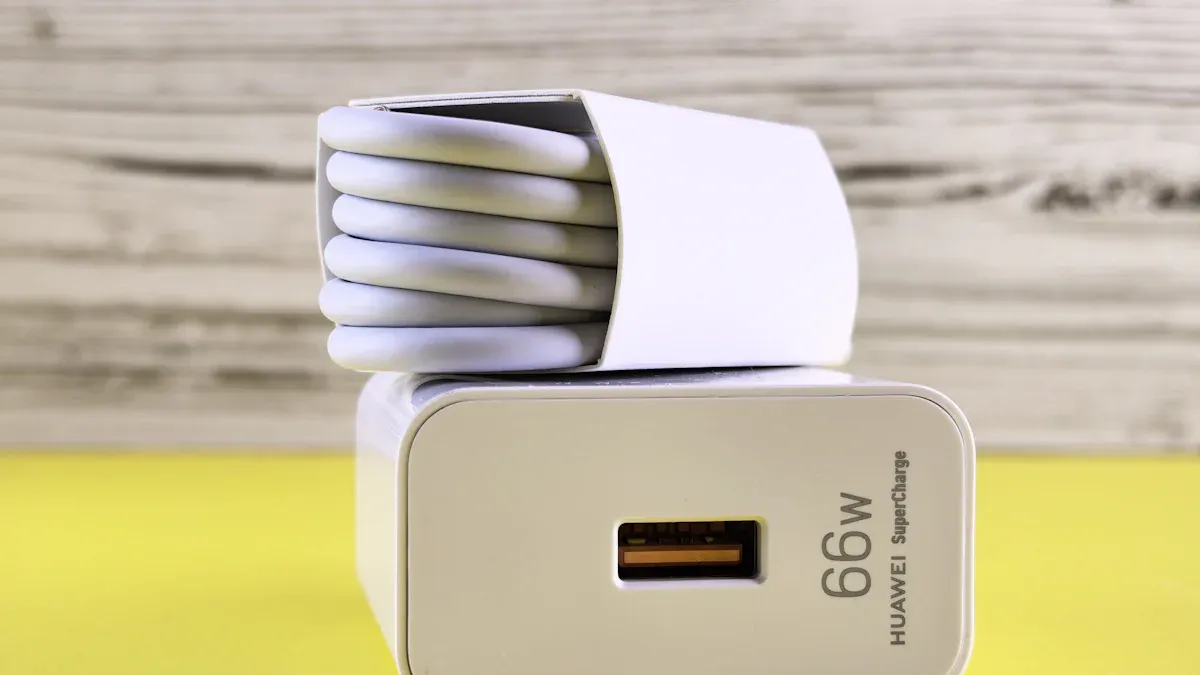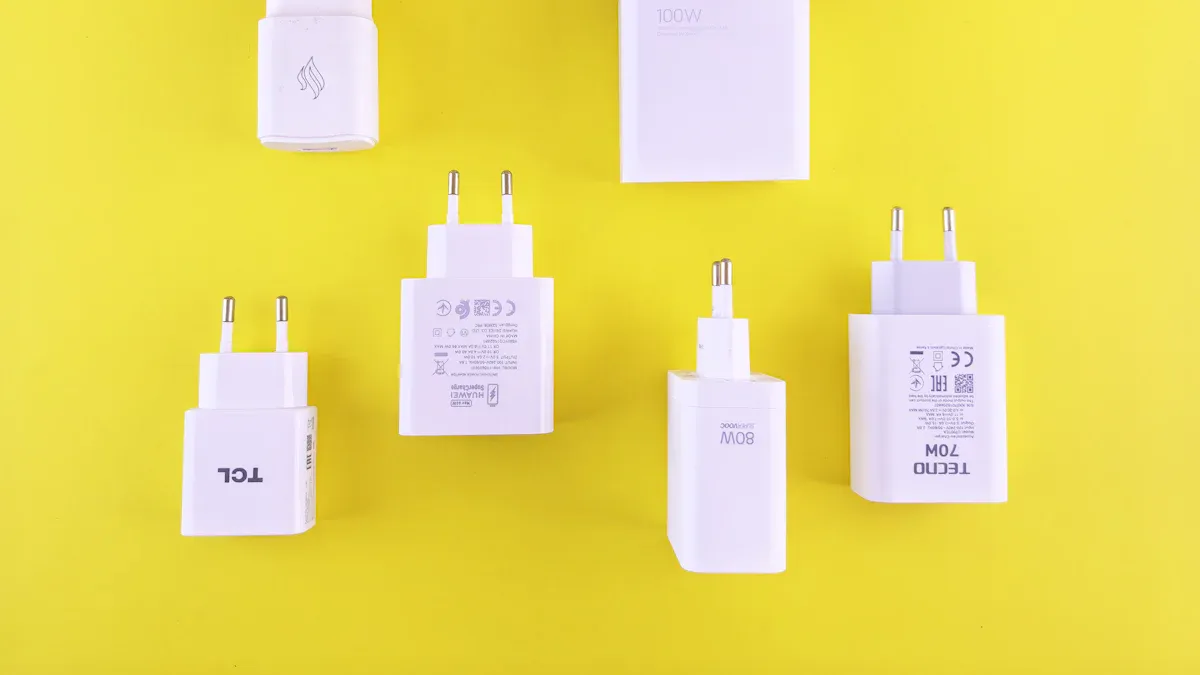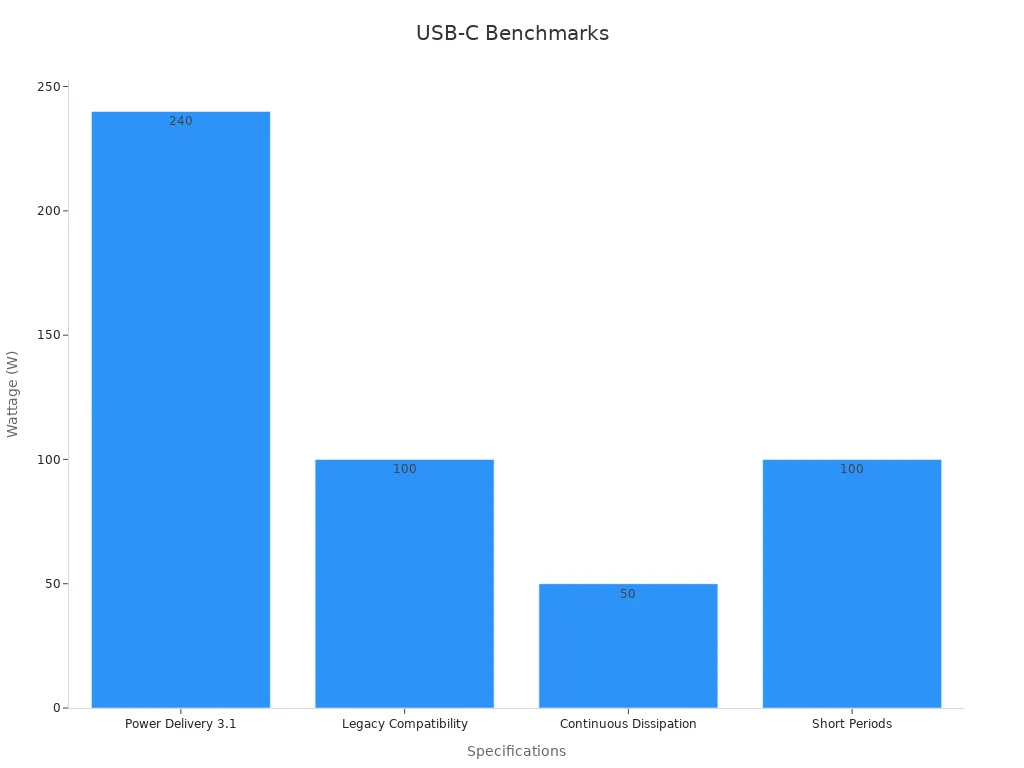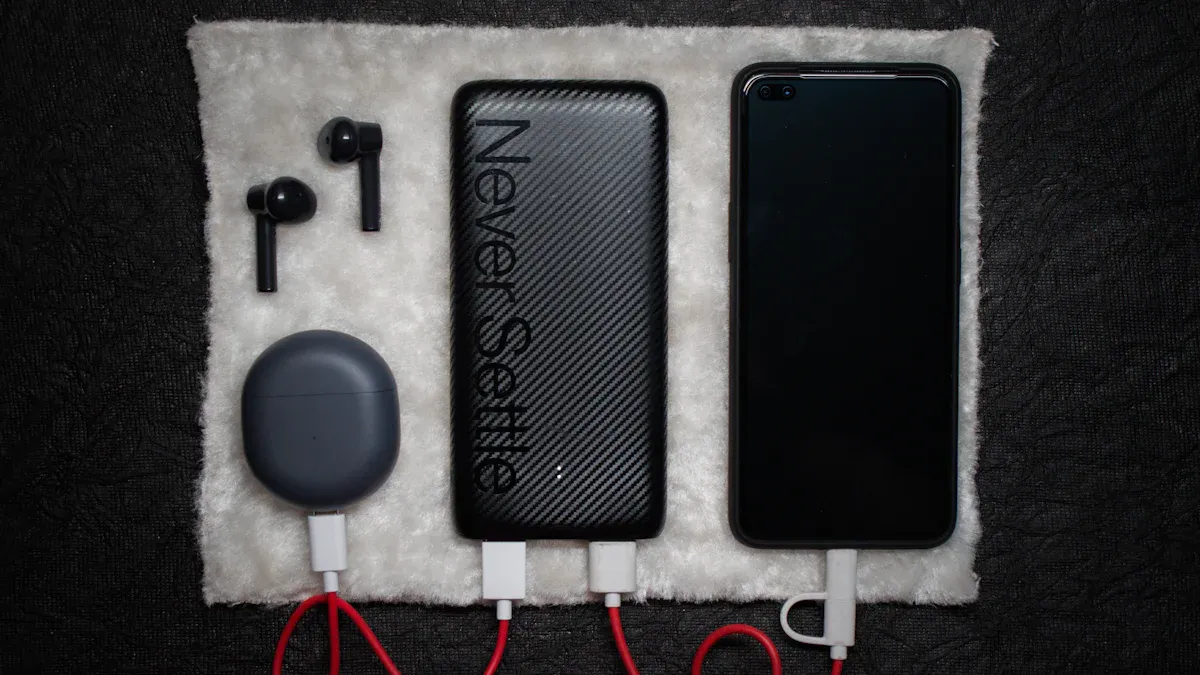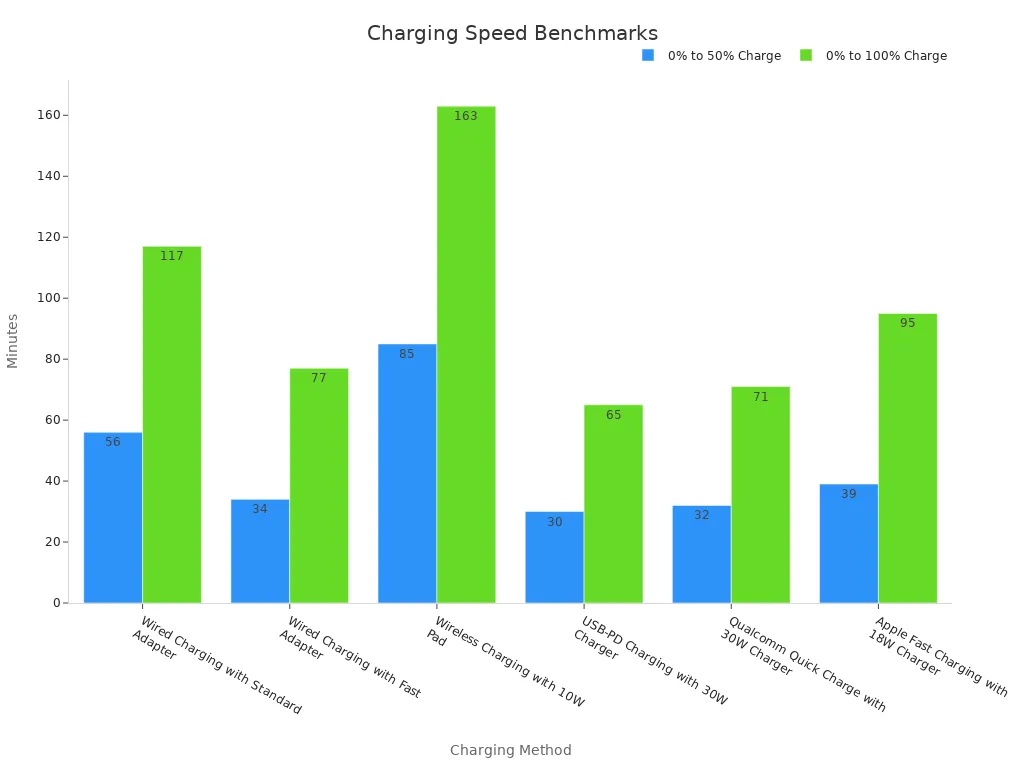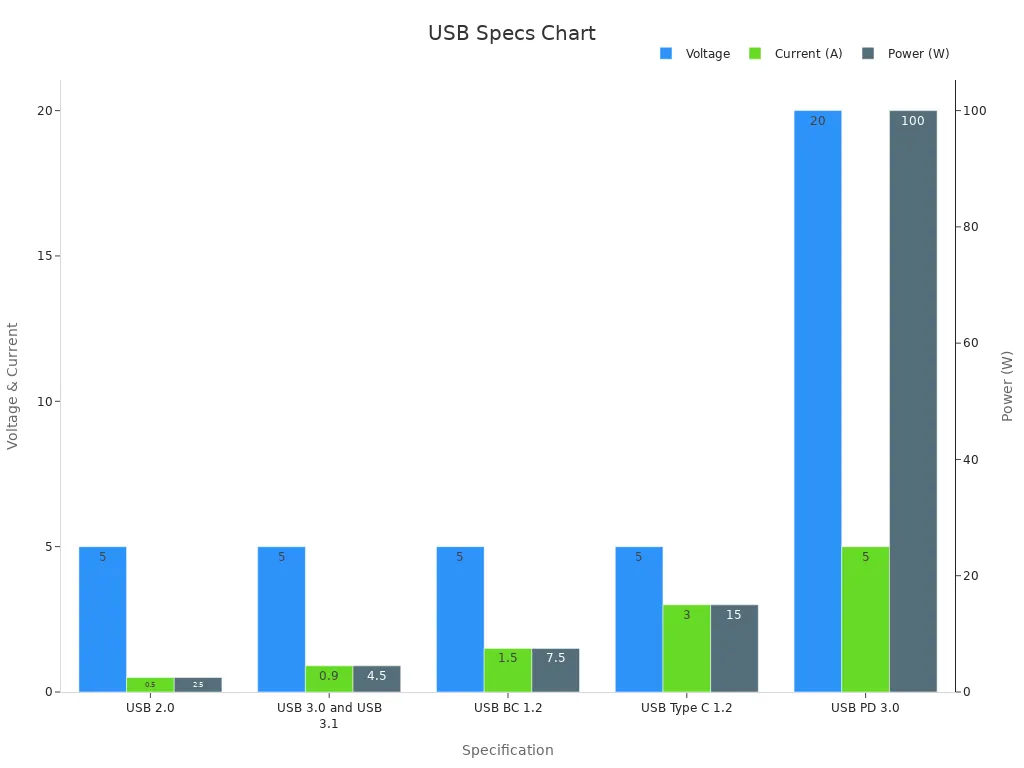Charging your devices efficiently can save precious time. A quick charge plug delivers higher power to your device, allowing it to charge at a faster rate compared to a regular plug. This technology boosts speed, making it ideal for modern lifestyles. You’ll notice how it caters to newer devices that demand more power for optimal charging. Regular plugs, on the other hand, stick to standard charging speeds, which work well for older gadgets or when speed isn’t a priority.
How Quick Charge Technology Works
Power Output and Fast Charging
Quick Charge technology revolutionizes how you power your devices by delivering higher power output. This innovation allows your gadgets to charge at significantly faster rates compared to traditional methods. For instance:
– It can charge devices up to four times faster than standard 5W chargers.
– Quick Charge 2.0 introduced higher charge levels, overcoming the limitations of older USB charging methods.
– Quick Charge 3.0, with its Intelligent Negotiation for Optimal Voltage (INOV), ensures efficient power transfer.
The advancements in Quick Charge 3.0 make it 16% faster and 38% more efficient than its predecessor, Quick Charge 2.0. With Dual Charge+ technology, it achieves up to 27% faster speeds and 45% greater efficiency. This means less time waiting for your device to charge and more time using it. Additionally, the technology reduces resistive loss and heating, ensuring safer and more reliable charging.
Tip: To fully benefit from fast charging, always use high-quality USB-C to USB-C cables or USB-C to Lightning cables. These cables support higher power delivery and maintain charging efficiency.
USB-C Charging and Power Delivery Standards
USB-C charging has become the gold standard for modern devices. Its reversible design and ability to handle higher power delivery make it a favorite for manufacturers and users alike. The USB Power Delivery (USB-PD) standard, which works seamlessly with USB-C, ensures that your devices receive the optimal amount of power.
Here are some key benchmarks for USB-C charging and USB Power Delivery:
| Specification | Benchmark |
|---|---|
| Power Delivery 3.1 | Up to 240W |
| Legacy Compatibility | Up to 100W |
| Continuous Dissipation | 50W |
| Short Periods | Up to 100W |
| Programmable Power Supply | Variable output voltage |
USB-C charging supports high-speed data transfer and higher power delivery, making it ideal for laptops, tablets, and smartphones. The Programmable Power Supply (PPS) feature allows for variable output voltage, ensuring efficient charging for devices with different power requirements.
Note: To choose the right USB-C cable, check the specifications of your device and ensure the cable supports USB Power Delivery standards.
iPhone Fast Charging Compatibility
If you own an iPhone, you’ll be pleased to know that Quick Charge technology supports iPhone fast charging. Using a USB-C to Lightning cable, you can charge your iPhone from 0% to 50% in just 30 minutes. This feature is especially useful when you’re short on time and need a quick power boost.
Apple’s newer models, such as the iPhone 12 and later, are designed to work seamlessly with USB-C charging and USB Power Delivery standards. These devices benefit from higher power delivery, ensuring fast and efficient charging. However, to achieve these high speeds, you must use a compatible charger and cable.
Tip: Always choose the right USB-C cable for your iPhone. Look for cables certified by Apple’s MFi (Made for iPhone) program to ensure compatibility and safety.
Benefits of Using a Quick Charge Plug
Faster Charging for Busy Lifestyles
A quick charge plug is perfect for keeping up with your fast-paced life. It delivers faster charging times, ensuring your devices are ready when you need them most. Imagine having only a few minutes before an important meeting. With fast charging, you can power up your iPhone or other devices quickly and stay connected throughout the day.
Professionals who rely on their smartphones benefit greatly from this technology. Quick chargers allow you to recharge during short breaks, minimizing downtime and keeping you productive. In just 30 minutes, many devices can reach a full charge, saving you valuable time compared to regular chargers. This efficiency makes a quick charge plug an essential tool for anyone with a busy schedule.
Time-Saving Convenience
Fast charging offers more than just speed—it provides unmatched convenience. You no longer need to wait hours for your devices to charge. Whether you’re heading out the door or preparing for a long day, a quick charge plug ensures your devices are ready in record time.
This convenience is especially useful for travelers. USB-C charging, which is common in quick chargers, supports a wide range of devices, including laptops, tablets, and smartphones. You can carry one charger for all your gadgets, reducing clutter and simplifying your routine. By cutting down on charging times, you gain more freedom to focus on what matters most.
USB-C Charging for Modern Devices
USB-C charging has become the standard for modern devices. Its ability to handle higher power delivery makes it ideal for fast charging. Many newer devices, including iPhones, are designed to work seamlessly with USB-C technology. This ensures faster charging times and greater efficiency.
The versatility of USB-C charging is another major advantage. It supports high-speed data transfer and works with a variety of devices. Whether you’re charging a smartphone, tablet, or laptop, USB-C ensures optimal performance. By investing in a quick charge plug, you future-proof your charging setup and enjoy the benefits of cutting-edge technology.
Limitations of Quick Charge Plugs
Higher Cost Compared to Regular Plugs
Quick Charge plugs often come with a higher price tag compared to regular plugs. This cost difference stems from the advanced technology required to deliver fast charging and higher power levels. For example, DC fast charging equipment, which powers Quick Charge plugs, can handle up to 50 kW, while regular plugs typically operate at much lower levels.
| Charging Type | Power Level | Description |
|---|---|---|
| Low AC | <2.3 kW | Socket charging without designated equipment |
| Medium AC | 3.7–7.4 kW | Single-phase AC charging equipment |
| High AC | 11–22 kW | Three-phase AC charging equipment |
| DC | 50 kW | DC fast charging equipment |
If you’re looking for affordability, regular plugs may be a better option. However, if speed and efficiency are priorities, investing in a suitable usb-c charger with Quick Charge capabilities might be worth the extra cost.
Compatibility with Older Devices
Quick Charge plugs are designed for modern devices that support usb-c charging. Older gadgets, which rely on traditional charging methods, may not benefit from the fast charging capabilities of these plugs. In some cases, using a Quick Charge plug with an older device could result in slower charging speeds or even incompatibility.
You should check your device’s specifications before purchasing a Quick Charge plug. If your device doesn’t support usb-c or fast charging, a regular plug might be more suitable. This ensures your device charges efficiently without unnecessary expenses.
Dependence on High-Quality USB-C Cables
To achieve optimal performance, Quick Charge plugs require high-quality usb-c cables. These cables play a crucial role in delivering power efficiently and safely. Unlike traditional cables, modern usb-c cables contain circuits that communicate with the charger and device, ensuring proper power delivery.
Here’s what you should look for when choosing usb-c cables:
– USB-C Version and Speed: Match the cable to your device’s capabilities.
– Charging Speed and Power Delivery: Select cables that support Power Delivery for faster charging.
– Quality and Certification: Opt for cables from reputable brands or certified manufacturers.
| Aspect | Details |
|---|---|
| Cables Considered | 50 usb-c cables and adapters |
| Cables Tested | 30 cables with speed and signal integrity tests |
| Testing Equipment | Total Phase Advanced Cable Tester |
| Key Findings | Substandard cables can limit power delivery, cause heat, and reduce performance. |
Using substandard cables can lead to issues like high resistance, overheating, and poor charging efficiency. To avoid these problems, invest in high-quality usb-c cables that match your device’s requirements.
Quick Charge Plug vs. Regular Plug: A Detailed Comparison
Charging Speed Differences
The most noticeable difference between a quick charge plug and a regular plug lies in their charging speed. Quick charge plugs deliver significantly faster results, making them ideal for modern devices. For example, using a USB-PD charger with 30W power, you can charge your device from 0% to 50% in just 30 minutes. In contrast, a standard adapter takes nearly twice as long to achieve the same result.
| Charging Method | Time to Charge from 0% to 50% | Time to Charge from 0% to 100% |
|---|---|---|
| Wired Charging with Standard Adapter | 56 minutes | 117 minutes |
| Wired Charging with Fast Adapter | 34 minutes | 77 minutes |
| Wireless Charging with 10W Pad | 85 minutes | 163 minutes |
| USB-PD Charging with 30W Charger | 30 minutes | 65 minutes |
| Qualcomm Quick Charge with 30W Charger | 32 minutes | 71 minutes |
| Apple Fast Charging with 18W Charger | 39 minutes | 95 minutes |
Quick charge plugs excel in situations where time is limited. Whether you’re rushing to leave the house or need a quick boost during a break, fast charging ensures your device is ready when you are. However, regular plugs remain a reliable option for overnight charging or when speed isn’t a priority.
Tip: To maximize charging speed, pair your quick charge plug with a high-quality USB-C cable that supports USB power delivery.
Cost and Affordability
Quick charge plugs often come with a higher price tag compared to regular plugs. This cost difference reflects the advanced technology required to deliver fast charging and higher power levels. For instance, a USB-PD charger capable of delivering 100W power is more expensive than a standard 5W adapter.
If you’re on a budget, regular plugs offer a more affordable solution. They work well for older devices or situations where charging speed isn’t critical. However, investing in a quick charge plug can save you time and improve efficiency, especially if you own multiple modern devices.
Note: Consider your charging habits and device compatibility before deciding whether the added cost of a quick charge plug is worth it.
Device Compatibility and USB-C Charging
Device compatibility plays a crucial role in determining whether a quick charge plug or a regular plug is the better choice. Quick charge plugs are designed to work seamlessly with modern devices that support USB-C charging and USB power delivery standards. These technologies ensure efficient power transfer and faster charging times.
| Specification | Maximum Voltage | Maximum Current | Maximum Power |
|---|---|---|---|
| USB 2.0 | 5V | 500mA | 2.5W |
| USB 3.0 and USB 3.1 | 5V | 900mA | 4.5W |
| USB BC 1.2 | 5V | 1.5A | 7.5W |
| USB Type C 1.2 | 5V | 3A | 15W |
| USB PD 3.0 | 20V | 5A | 100W |
USB-C charging offers several advantages, including faster speeds, bi-directional power flow, and compatibility with a wide range of devices. For example, iPhone fast charging relies on USB-C to Lightning cables to deliver optimal performance. However, older devices that use USB-A or USB-B ports may not benefit from the advanced features of a quick charge plug.
Advantages of USB-C Charging:
– Supports various USB versions.
– Designed for efficient charging and data transfer.
– Reversible and easy to use.
– Budget-friendly compared to other advanced charging technologies.Disadvantages of USB-C Charging:
– Charging speed may decrease over time.
– Potential data leakage due to high resistance.
– Limited power delivery compared to USB power delivery standards.
When choosing between a quick charge plug and a regular plug, consider the specifications of your devices. If your gadgets support USB-C charging and USB power delivery, a quick charge plug will provide faster and more efficient results. For older devices, a regular plug may be a more practical and cost-effective option.
Portability and Design
When choosing between a quick charge plug and a regular plug, portability and design play a significant role. You want a charger that fits your lifestyle, whether you’re traveling, commuting, or working from home. Let’s explore how these two options compare in terms of size, weight, and overall convenience.
Compact Size for Travel
Quick charge plugs are often designed with portability in mind. Many models are smaller and lighter than traditional chargers, making them easy to carry in your bag or pocket. This compact size is especially useful for frequent travelers. You can pack a single quick charge plug to power multiple devices, thanks to its compatibility with usb-c technology.
Regular plugs, on the other hand, tend to be bulkier. They may not fit as easily into tight spaces or travel cases. If you value portability, a quick charge plug is the better choice.
Tip: Look for quick charge plugs with foldable prongs. This feature reduces the risk of damage during travel and makes the plug even more compact.
Multi-Port Designs for Convenience
Many quick charge plugs come with multiple usb-c ports, allowing you to charge several devices at once. This feature eliminates the need to carry multiple chargers, saving you space and reducing clutter. For example, you can charge your smartphone, tablet, and laptop simultaneously with a single quick charge plug.
Regular plugs usually have only one port, limiting their functionality. If you own multiple devices, you might find yourself switching cables or using multiple outlets. Quick charge plugs simplify this process, making them more convenient for modern users.
Sleek and Modern Aesthetics
Quick charge plugs often feature sleek, modern designs that complement the look of your devices. Manufacturers prioritize aesthetics, offering chargers in various colors and finishes. These designs not only look good but also enhance usability. For instance, some quick charge plugs include LED indicators to show charging status.
Regular plugs, while functional, lack the same level of design innovation. They often have a basic, utilitarian appearance. If style matters to you, a quick charge plug is the more appealing option.
Durability and Build Quality
Quick charge plugs are built to handle higher power levels, which often means they are made from more durable materials. Many models include safety features like overheat protection and short-circuit prevention. These features ensure the plug lasts longer and performs reliably.
Regular plugs, while sturdy, may not offer the same level of durability. They are designed for standard charging and may wear out faster when used frequently. If you want a charger that stands the test of time, a quick charge plug is a worthwhile investment.
Note: Always check the build quality and safety certifications of any charger you purchase. High-quality materials and proper certifications ensure safe and efficient charging.
Summary of Portability and Design
Quick charge plugs excel in portability, offering compact sizes, multi-port functionality, and modern designs. They are ideal for travelers, professionals, and anyone who values convenience and style. Regular plugs, while reliable, fall short in these areas. If you prioritize portability and design, a quick charge plug is the clear winner.
Quick Charge plugs offer unmatched speed and efficiency, making them ideal for modern devices like the iPhone. If you own an iPhone, you’ll appreciate how quickly it powers up with a compatible Quick Charge plug. These chargers save time and keep your devices ready for use. However, regular plugs remain a dependable choice for standard charging needs. They work well for older gadgets or when speed isn’t a priority.
When deciding, consider your iPhone’s compatibility, your budget, and how often you need fast charging. By understanding your habits, you can choose the best plug for your lifestyle.
FAQ
1. Can I use a Quick Charge plug with any device?
Quick Charge plugs work best with devices that support fast charging or USB-C technology. Older devices may not benefit from the speed and efficiency of these plugs. Always check your device’s specifications to ensure compatibility.
2. Do Quick Charge plugs damage batteries over time?
No, Quick Charge plugs do not harm batteries if you use them correctly. Modern devices include built-in safeguards to prevent overcharging or overheating. Use high-quality cables and certified chargers to maintain battery health.
3. Are Quick Charge plugs worth the extra cost?
If you value faster charging and own modern devices, Quick Charge plugs are worth the investment. They save time and improve convenience. However, for older devices or occasional use, regular plugs may suffice.
4. What is the difference between USB-C and USB-A?
USB-C supports faster charging and data transfer compared to USB-A. It also features a reversible design, making it easier to use. USB-C is the standard for modern devices, while USB-A is common in older gadgets.
5. How do I choose the right Quick Charge plug?
Look for a plug that matches your device’s power requirements. Check for USB Power Delivery (USB-PD) support and ensure it has the correct wattage. Certified plugs from reputable brands offer better safety and performance.

